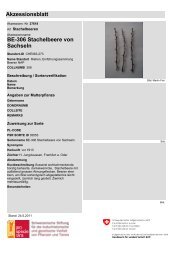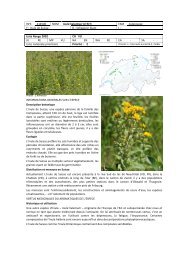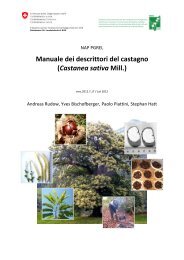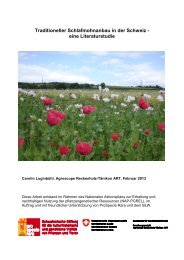Schlussbericht Crop Wild Relative
Schlussbericht Crop Wild Relative
Schlussbericht Crop Wild Relative
- TAGS
- schlussbericht
- crop
- wild
- relative
- bdn.ch
Sie wollen auch ein ePaper? Erhöhen Sie die Reichweite Ihrer Titel.
YUMPU macht aus Druck-PDFs automatisch weboptimierte ePaper, die Google liebt.
Threats<br />
Major threats to L. hispanicus are habitat alteration<br />
and loss, changes in agricultural practices and genetic<br />
pollution.<br />
The natural populations of Lupinus hispanicus occur in<br />
cereal fields, vineyards, olive orchards, road edges<br />
and shrubby land. Many populations are now in severe<br />
decline due to agricultural abandonment and<br />
human intervention (urbanization, road widening,<br />
etc). The photograph shows road widening in<br />
Casavieja, Spain, which partially destroyed a L. hispanicus<br />
population<br />
Gap detection in the ex situ conservation of<br />
Lupinus hispanicus, using herbarium records<br />
Gap detection in the ex situ conservation of Lupinus<br />
and predictive models.<br />
hispanicus using herbarium records and predictive<br />
models.<br />
Gene bank<br />
records<br />
Gaps detected<br />
With herbarium<br />
data<br />
The role of L. hispanicus in agriculture and<br />
sustainable development<br />
• This crop wild relative was traditionally harvested by farmers for use as fodder. However, the high<br />
proportion of toxic, bitter alkaloids found in this species has limited its wider use.<br />
• Lupinus hispanicus as a crop for sustainable development: As this species has nitrogen-fixing nodules<br />
on its roots, it assimilates nitrogren and fixes it in the soil, thereby reducing fertilizer requirements<br />
in subsequent crops. Thus, it has the potential to increase the efficiency of N use in arable<br />
rotations and in mixed arable livestock systems.<br />
• Breeding qualities of Lupinus hispanicus: the species has a high oil content in seeds, and both the<br />
plant and its seeds have a 30-50% protein content. Lupinus hispanicus has a high tolerance to<br />
many pests and diseases, requiring fewer insecticides and fungicides than other high-protein<br />
crops such as soybean and peas. Other traits include cold tolerance and adaptation to poor<br />
soils.<br />
• Experimental cultivation of L. hispanicus began in 1988 using seeds from natural populations to<br />
provide summer pastures for sheep and goats.<br />
Literature cited<br />
Castroviejo, S. et al. 1999 Flora Iberica<br />
Parra-Quijano, M. et al. 2003 Assessing conservation of Lupinus spp. in Spain through GIS. <strong>Crop</strong> <strong>Wild</strong> <strong>Relative</strong> 1: 8-9.<br />
www.pgrforum.org<br />
Conservation<br />
In situ<br />
Half of the known 174 L. hispanicus<br />
populations are located in the<br />
Natura Network of Sites of Community<br />
Interest. Predictive distribution<br />
models have been used to assess<br />
the overall occurrence of L. hispanicus<br />
in protected areas (shown on<br />
the left).<br />
Ex situ<br />
A large collection of L. hispanicus<br />
seeds is maintained in European<br />
and Australian national seed banks.<br />
GIS-based methodologies have<br />
been used to detect biases in collections<br />
and to identify additional<br />
collection sites to capture greater<br />
genetic diversity for ex situ collections.








